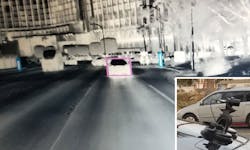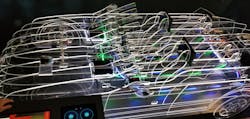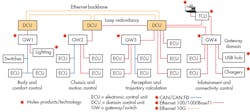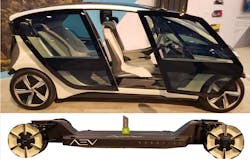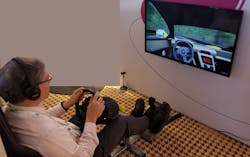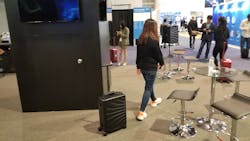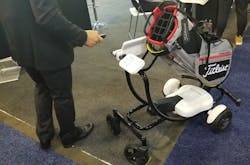Though auto and vehicle makers save most of their new product announcements for the auto show later in the year, they take advantage of the Consumer Electronics Show to highlight the latest technology. This includes a host of prototypes and concept cars.
Beyond the cars themselves, vendors like AdaSky are also featuring their wares. In AdaSky’s case, it’s a tiny thermal sensor (Fig. 1). It’s smaller than a roll of quarters, but it provides a VGA thermal image that reveals more than a camera or radar can provide. The far-infrared (FIR) sensor is passive, so it will not damage digital cameras like some LiDAR systems were doing at CES. It also does a better job of identifying people because of its thermal nature.
1. AdaSky’s tiny thermal sensor (bottom right) provides VGA resolution thermal images.
The demo ride I had in AdaSky’s car presented real-time object detection using NVIDIA’s Jetson AGX Xavier. It was able to pick out people over 200 meters away. The Viper sensor can detect thermal differences of 0.05°C at three times the range of automotive headlights. The shutterless system uses a custom ASIC and can be combined with AI applications running on platforms like the Jetson AGX Xavier.
I decided to skip the array of concept cars at CES, but did need to mention the massive John Deere combine (Fig. 2). It uses GPS and cameras for navigation and collision avoidance. The company’s AutoTrac system is already deployed.
2. John Deere’s combine can operate autonomously in the field.
Molex was highlighting its car communication electronics with a 10G Ethernet backbone (Fig. 3). The plexiglass car representation exposed the large number of connections within self-driving cars.
3. Molex brought 10G Ethernet into the mix to deliver the throughput needed for self-driving cars.
Central to Molex’s view of vehicle networks is its intelligent 10G Ethernet switches (Fig. 4). These also provide gateway support to all on-board networks from USB to 1000Base-T1 automotive Ethernet. It also handles CAN, CAN-FD, and LIN networks.
4. Molex’s 10G Ethernet switches provide a redundant backbone for linking sensors to compute resources within a vehicle.
“With the global automotive Ethernet market projected to grow by more than 20% each year over the next several years, OEMs are seeking solutions that are compatible with existing network components while being flexible enough to integrate new technology and accommodate different vehicle profiles,” said Dave Atkinson, director of business development, connected mobility solutions, Molex. “Our solution is based on a future-ready, automotive-grade gateway delivering seamless integration across multiple hardware and software systems and legacy automotive protocols.”
AEV Robotics has an electric-vehicle platform that can morph into any number of different vehicles using a common “skateboard” base and pods that provide customized support for a range of applications (Fig. 5). The applications include taxi service, on-demand ride sharing, delivery, and industrial logistics. The platforms are integrated with NVIDIA computational and machine-learning platforms. The platforms are available with 15- and 30-kWh batteries. They’re designed to work with inductive chargers.
5. AEV’s platform (bottom) can be equipped with any number of platforms (top) for moving people or cargo autonomously.
STMicroelectronics (ST) was showing off a number of vehicle-to-everything (V2X) demos (Fig. 6). I was given warnings about oncoming cars that I could not see, as well as cars braking ahead of me also hidden by a car directly in front of me.
6. I checked out STMicroelectronics' V2X demo that warned me about events I could not see, like a car stopping ahead of the one I was driving behind.
There are now two V2X communication technologies. The first was dedicated short-range communications (DSRC) or 802.11p. It uses OFDM with CSMA. It has been out since 2017 and will be deployed this year. The cellular V2X (C-V2X) is out now and will be deployed in 2020—it uses 4G and 5G cellular technology. A number of other CES announcements addressed C-V2X, including those from Qualcomm, which is big into 5G.
Autotalks and ST were showing off their combined V2X solution that handles DSRC and C-V2X. ST’s chipset does one or the other at one time, but this allows a vehicle to handle either environment. DSRC is being used in the US.
COWAROBOT’s Rover Speed suitcase on Kickstarter will follow you (Fig. 7). This autonomous robot utilizes radar and camera sensors to avoid obstacles and people while keeping up with you. It will even notify your smartphone if it’s more than two meters away. Moreover, the smartphone app provides remote-control support. Like a car’s cruise control, making a change like grabbing the handle switches the unit to manual mode. The unit has retractable, motorized wheels in the center for traction.
7. Rover Speed’s robotic suitcase on Kickstarter will follow you to your gate.
It’s the usual size for fitting in the luggage racks, but you will have to pick it up to do so. It only knows how to roll around. There’s a removable lithium battery in case you need to check it. It also has TSA-compliant smart locks.
Rover Speed works in an airport or on most flat surfaces, although it’s not great on the golf course. TTNG’s HelloCaddy will also follow you around the golf course (Fig. 8). Just add your golf bag and prepare for a robotic caddy that will give you advice, too, if you ask for it. HelloCaddy is targeted at golf courses where golfers can walk without lugging around the clubs.
8. TTNG’s HelloCaddy will follow you and give golf tips upon request.
About the Author
William G. Wong
Senior Content Director - Electronic Design and Microwaves & RF
I am Editor of Electronic Design focusing on embedded, software, and systems. As Senior Content Director, I also manage Microwaves & RF and I work with a great team of editors to provide engineers, programmers, developers and technical managers with interesting and useful articles and videos on a regular basis. Check out our free newsletters to see the latest content.
You can send press releases for new products for possible coverage on the website. I am also interested in receiving contributed articles for publishing on our website. Use our template and send to me along with a signed release form.
Check out my blog, AltEmbedded on Electronic Design, as well as his latest articles on this site that are listed below.
You can visit my social media via these links:
- AltEmbedded on Electronic Design
- Bill Wong on Facebook
- @AltEmbedded on Twitter
- Bill Wong on LinkedIn
I earned a Bachelor of Electrical Engineering at the Georgia Institute of Technology and a Masters in Computer Science from Rutgers University. I still do a bit of programming using everything from C and C++ to Rust and Ada/SPARK. I do a bit of PHP programming for Drupal websites. I have posted a few Drupal modules.
I still get a hand on software and electronic hardware. Some of this can be found on our Kit Close-Up video series. You can also see me on many of our TechXchange Talk videos. I am interested in a range of projects from robotics to artificial intelligence.

